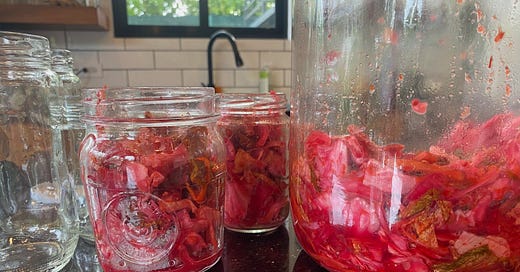Costa Rican Kimchi, errr, Fresh Thymes Kimchi, errr, Christine’s Kimchi
Intimidated by the idea of fermenting? I totally understand. I was also intimidated. How would I know it was going okay in that dark jar? Would I kill myself or my neighbors? What if I did it wrong? Beginning to ferment is a great way to build a more commensal relationship with the microbes in your environment. It builds your innate intuition and your trust in nature. The two gold standards of fermentation are The Nose Knows and Under the Brine It’s Fine.
The Nose Knows. If the ferment smells good, like a pickle, or sauerkraut, or kimchi, then it’s fine. If a ferment goes south, the odor will not be enticing. There will be other funky indicators as well. And bacteria of the kind that would thwart a ferment can’t do so in an anaerobic, acidic, salty environment. Hence, under the brine, it’s fine. I suggest getting a good basic fermentation cookbook and begin following on social, etc. My favorite ferment Goddess is Kirsten Shockey, her resources are endless. Be brave!! Begin to ferment your favorite condiment!
Costa Rica Kimchi
Yield: 3-4 quarts
Equipment Needed:
1-2 wide-mouth glass jars large enough to hold 4 quarts total (1 gallon jar or two half gallon). I like this set-up.
Ferment weights - this could be something you buy, but also another type of weight that will fit inside the jar and hold the ferment below the surface of the brine. In a pinch, I use two plastic ziplock bags inside each other. One filled with water and the second one as insurance against water leakage into the ferment, and use that as a weight (which I just did in this batch here in Costa Rica)
A dishtowel, cloth or even coffee filter to cover the opening of the jar, with a rubber band to enclose.
This fermentation kit, uses a wood pounder to further break down the vegetables and has a fermentation lid that fits ball jars.
The quality of the vegetables matter. Fermentation is diminished or not possible on conventionally grown vegetables. And you don’t want to ferment petroleum chemicals. Choose organic. Also, make sure to use sea salt and filtered water.
Ingredients:
Kimchi
1 large head Organic napa cabbage, outer leaves removed, cleaned and set aside
1 small head Organic red cabbage
2 cups Organic scallions, thick cut on the bias
1 ½ cups shredded Organic white or purple daikon or watermelon radish
1 ½ cups shredded carrots - look for purple ones
1 red onion
¼ cup + 1 tbsp sea salt
Spice Slurry
6 - 8 garlic cloves
3 tbsp sambal or sriracha
2 tbsp minced ginger
⅓ cup filtered water
First, clean your equipment and space well. Thoroughly wash and dry with a clean dishtowel - mixing bowls, jars, cutting boards and countertops.
Wash all your produce well. You only need water, we don’t need to kill anything on the vegetables, just make sure it’s clean of dirt and debris.
Chop your cabbage and place in a large bowl. Add the scallions, radish, carrots and red onion. Add the salt, and using your clean dry hands, mix all the ingredients together, making sure the salt gets thoroughly mixed in. Set aside to make the slurry.
In a blender, combine all the ingredients for the spice slurry.
Once pureed, pour over the vegetables and using clean hands, massage the slurring into all the vegetables. Try to cover all the surfaces of the vegetables. Allow to sit for 5-10 minutes, to allow the salt to further begin extracting the juice from the vegetables.
Toss again to combine all the ingredients.
In 1 glass jar large enough to hold everything, or two large mason jars, begin to pack the kimchi. Fill the jar and make a fist, using it to push and pack down the cabbage into the jars, allowing for the juices to rise and eliminating air holes between the vegetables.
Allow the ferment to rest, periodically packing the cabbage deeper into the brine.
After and hour or two, using the reserved cabbage leaves, push those down into the kimchi, using the cabbage leaves to cover the fermentation. Add the ferment weights to the top of the cabbage leaves, pushing down to further submerge the kimchi below the brine.
Cover the mouth of the jar with a clean towel or coffee filter, using a rubber band to secure. While we want the beneficial bacteria in the air to inoculate the kimchi, we don’t want any other debris or interested insects, so make sure the top of the jar is secured.
Place in a cool dark place for 3-4 weeks.
Unpack, discard the cabbage leaves and enjoy. Will keep indefinitely in the refrigerator.
TIP:
Cabbage is what I call a Keeper Crop. Meaning it can languish in storage for ages before it gets used. As such, when you purchase cabbage in March or April, it’s been “keeping” since the previous summer’s harvest. That's not bad, it just means it’s lost much of it’s water content. Older cabbage isn’t as juicy and doesn’t weep as much liquid as needed to cover the vegetables. In that case, add enough filtered water to make sure the brine meets the level of the vegetables and all vegetables are below the brine.
Another method to further extract the natural juice of the cabbage is to use a wood pounder, or mallet to pound the vegetables after the salt is added. Pound the vegetables, tossing in between pounding. In a few minutes, you should begin to see a significant amount of liquid being exuded. This also serves the purpose of breaking down the vegetables so they fit in the ferment jar. They will naturally collapse into themselves during the fermentation process.






